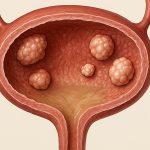Prostatic urethral nodules (PUNs), often discovered incidentally during digital rectal examinations or imaging for other urological concerns, represent a significant challenge in benign prostatic hyperplasia (BPH) management. These nodules are distinct from the typical hypertrophic changes associated with BPH; they tend to be firmer, located more centrally within the prostate and urethra, and can disproportionately contribute to lower urinary tract symptoms (LUTS). Traditional medical therapies for BPH, such as alpha-blockers or 5-alpha reductase inhibitors, often provide limited relief specifically targeting PUNs. This is because their mechanism of action focuses on reducing overall prostate size rather than addressing the localized obstruction caused by these nodules. Consequently, patients with prominent PUNs may experience persistent and bothersome LUTS despite optimal medical management, necessitating alternative interventions.
The increasing demand for less invasive treatment options has spurred interest in minimally invasive debulking techniques specifically aimed at targeting PUNs. These methods offer a potential middle ground between conservative medical therapy and more aggressive surgical approaches like transurethral resection of the prostate (TURP) or open prostatectomy. The goal is to alleviate obstruction without inducing significant morbidity associated with traditional surgery, preserving sexual function, and minimizing postoperative complications. This article will delve into the evolving landscape of minimally invasive debulking techniques for prostatic urethral nodules, exploring their mechanisms, indications, procedural details, and current evidence regarding efficacy and safety.
Minimally Invasive Debulking Techniques: An Overview
Several minimally invasive techniques have emerged as viable options for PUN debulking. These approaches generally fall into categories based on the energy source used to ablate or vaporize prostatic tissue. Transurethral enucleation-resection of the prostate (TUREP) and photoselective laser ablation of the prostate (PLAP), while sometimes considered traditional treatments, can be adapted for targeted nodule resection. However, newer modalities like holmium laser enucleation of the prostate (HoLEP), thulium fiber laser enucleation of the prostate (ThuLEP), and prostatic urethral lift (PUL) are gaining traction due to their precision and reduced risk profiles. The selection of an appropriate technique depends on several factors including nodule size, location, patient anatomy, and surgeon expertise. The core principle remains consistent: selectively remove obstructing tissue while preserving as much functional prostate and urinary continence as possible. Considering the advancements in laser technology, exploring options like prostate tissue vaporization can offer effective relief.
These techniques differ significantly in their approach to tissue removal. HoLEP and ThuLEP involve enucleation – precisely dissecting the nodule from surrounding tissue before morcellating and removing it. PLAP utilizes laser energy to vaporize the obstructing tissue, reducing prostate size through ablation rather than resection. PUL, on the other hand, doesn’t remove tissue; it strategically lifts and compresses the urethra, relieving obstruction without causing thermal damage. Importantly, many of these techniques can be performed under image guidance (e.g., ultrasound or MRI) to enhance precision and minimize collateral damage.
The advantage of these minimally invasive methods lies in their ability to address PUNs directly, unlike traditional BPH therapies that treat the entire gland. This targeted approach minimizes the risk of postoperative complications like retrograde ejaculation, a common concern with TURP. Furthermore, shorter hospital stays, quicker recovery times, and improved patient satisfaction are frequently reported compared to open surgical interventions. However, it’s crucial to remember that each technique has its own set of potential risks and benefits, and careful patient selection is paramount for optimal outcomes.
Current Evidence & Outcomes
The evidence base supporting the use of minimally invasive debulking techniques specifically for PUNs is still evolving. Initial studies and retrospective analyses have demonstrated promising results, but larger randomized controlled trials are needed to definitively establish their superiority over existing treatments. HoLEP and ThuLEP consistently show significant improvements in LUTS, including reductions in International Prostate Symptom Score (IPSS) and post-void residual volume. These techniques also boast low rates of urinary incontinence and sexual dysfunction compared to TURP. PLAP offers similar benefits but may be associated with a slightly higher risk of urethral stricture formation.
PUL, while demonstrating excellent outcomes for patients with obstructive symptoms due to BPH, may not be as effective for large PUNs causing significant obstruction. It’s more suited for patients with moderate LUTS and relatively smaller nodules. The long-term durability of these techniques remains a key area of investigation. Some studies suggest that the benefits can persist for several years, but ongoing follow-up is necessary to assess the potential need for re-treatment over time. Furthermore, comparative studies evaluating different debulking techniques head-to-head are crucial to determine which approach offers the best balance between efficacy, safety, and patient satisfaction in specific clinical scenarios. For patients considering laser treatments, understanding laser debulking of prostate tissue nodules can provide valuable insight.
Patient Selection & Preoperative Assessment
Successful outcomes with PUN debulking heavily rely on careful patient selection and a thorough preoperative assessment. Not all patients presenting with LUTS are suitable candidates for these procedures. Ideal candidates typically have: – Moderate to severe LUTS refractory to medical management – A dominant prostatic urethral nodule contributing significantly to obstruction – Relatively small prostate volume (though this varies depending on the technique) – No contraindications to surgery or anesthesia
A comprehensive evaluation should include a detailed medical history, digital rectal examination, PSA level, urine analysis, post-void residual volume measurement, and urodynamic studies. Imaging modalities such as transrectal ultrasound (TRUS) with biopsy can help characterize the nodule’s size, location, and density. MRI may be used to further differentiate PUNs from other prostatic lesions. It’s essential to rule out prostate cancer before proceeding with any debulking procedure. Patients with a history of prior pelvic surgery or radiation therapy require careful consideration due to potential anatomical alterations and increased risk of complications. Open communication with the patient is paramount. They should be fully informed about the risks, benefits, and alternatives to these procedures, as well as realistic expectations regarding outcomes.
Surgical Technique & Postoperative Management
The specific surgical technique employed will vary depending on the chosen modality. However, certain principles are common across most minimally invasive debulking procedures. Generally, patients undergo spinal or general anesthesia. A resectoscope or laser fiber is inserted transurethrally to access the prostate. Image guidance may be utilized to precisely target the PUN. Tissue ablation or enucleation is then performed under direct visualization. The duration of the procedure varies depending on the size and location of the nodule, as well as the surgeon’s experience.
Postoperative management typically involves a short hospital stay (often 1-2 days), urinary catheterization for several days to allow for healing, and pain management. Patients are usually advised to avoid strenuous activity and heavy lifting for a few weeks. Regular follow-up appointments are scheduled to monitor urinary function, assess for complications, and evaluate the long-term efficacy of the procedure. Potential postoperative complications include hematuria (blood in urine), dysuria (painful urination), urethral stricture, urinary incontinence, and retrograde ejaculation. Prompt recognition and management of these complications are crucial for optimizing patient outcomes. Understanding the nuances of potential complications is key, and resources like information on recognizing signs of urethral irritation can be helpful.
Future Directions & Emerging Technologies
The field of minimally invasive PUN debulking is rapidly evolving. Several promising technologies are currently under development with the potential to further refine treatment options. Waterjet dissection, utilizing high-velocity water streams to precisely dissect tissue, offers a non-thermal approach that may minimize the risk of complications. Transurethral microwave thermotherapy (TUMT) and transurethral radiofrequency ablation (TUFA) are being explored as alternatives for targeted tissue ablation. Furthermore, advancements in image guidance technology, such as intraoperative MRI, promise to enhance precision and improve surgical outcomes.
Artificial intelligence (AI) and machine learning algorithms may play a role in patient selection, predicting treatment response, and optimizing surgical planning. Personalized medicine approaches, tailoring the choice of debulking technique based on individual patient characteristics and nodule morphology, are also gaining traction. The future of PUN management lies in developing more precise, less invasive, and highly effective therapies that preserve urinary function and quality of life for patients. Continued research and innovation will be essential to translate these advancements into clinical practice and improve the care of individuals with prostatic urethral nodules. Patients interested in a broader understanding of surgical options should explore minimally invasive surgery for prostate cancer removal, even if their condition is BPH related.
For those experiencing associated symptoms, it’s important to differentiate between potential causes; resources like information on urethral burning without signs of infection can help individuals understand their symptoms better.
Ultimately, a comprehensive approach that considers both the technical aspects and patient well-being is essential for achieving optimal results in PUN management. Furthermore, exploring prostate cryosurgery as a minimally invasive option can offer alternative pathways to treatment.





















